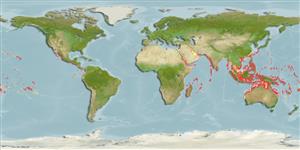>
Holocentriformes (Squirrelfishes, soldierfishes) >
Holocentridae (Squirrelfishes, soldierfishes) > Myripristinae
Etymology: Myripristis: Greek, myros, -ou = male of morey eel + Greek, pristis = saw (Ref. 45335).
Environment: milieu / climate zone / depth range / distribution range
Ecologia
marino associati a barriera corallina; distribuzione batimetrica 1 - 50 m (Ref. 9710). Tropical; 30°N - 35°S
Indo-Pacific: Red Sea (including the Gulf of Oman) and East Africa to Oceania.
Length at first maturity / Size / Peso / Age
Maturity: Lm 17.5 range ? - ? cm
Max length : 60.0 cm TL maschio/sesso non determinato; (Ref. 240); common length : 18.0 cm TL maschio/sesso non determinato; (Ref. 30573)
Spine dorsali (totale) : 11; Raggi dorsali molli (totale) : 13 - 15; Spine anali: 4; Raggi anali molli: 11 - 14. This species is distinguished by the following characters: robust and compressed body with big eyes; lower jaw with one pair of tooth patches at front of lower jaw just outside of gape; lower jaw of adults slightly projecting when mouth closed; gill rakers on first gill arch 11-15 (modally 13) on upper limb, total 36-44 (modally 39); lateral line scales 27-32 (modally 29); lower half to ¾ of axil of pectoral fins with small scales; interorbital space broad, its width 3.65- 4.4 times in head length. Colour of body red to dusky red, the edges of scales reddish brown; opercular membrane dark brown to black to about level of middle of eye; axil of pectoral fins dark brown to black; spinous dorsal fin light red on basal two-thirds, bright red on outer third; leading edges of soft dorsal, anal, caudal, and pelvic fins white (Ref. 12419, 40493).
Occur in reef flats and shallow lagoon and seaward reefs (Ref. 12419). Benthopelagic in or near crevices and caves (Ref. 58302). Mainly nocturnal. Feed mainly on plankton such as crab larvae (Ref. 12419). Secretive, hovering under ledges and in caves (Ref. 37816). Oviparous, with planktonic eggs and larvae (Ref. 240).
Life cycle and mating behavior
Maturità | Riproduzione | Deposizione | Uova | Fecundity | Larve
Randall, J.E. and D.W. Greenfield, 1996. Revision of the Indo-Pacific holocentrid fishes of the genus Myripristis, with descriptions of three new species. Indo-Pac. Fish. (25):61 p. (Ref. 12419)
IUCN Red List Status (Ref. 130435: Version 2024-1)
Threat to humans
Reports of ciguatera poisoning (Ref. 4690)
Human uses
Pesca: scarso interesse commerciale; Acquario: Commerciale
Strumenti
Special reports
Download XML
Fonti Internet
Estimates based on models
Preferred temperature (Ref.
123201): 24.7 - 29, mean 28 °C (based on 1080 cells).
Phylogenetic diversity index (Ref.
82804): PD
50 = 0.5000 [Uniqueness, from 0.5 = low to 2.0 = high].
Bayesian length-weight: a=0.01778 (0.01082 - 0.02921), b=3.06 (2.92 - 3.20), in cm total length, based on LWR estimates for this species & Genus-body shape (Ref.
93245).
Trophic level (Ref.
69278): 3.4 ±0.1 se; based on diet studies.
Resilienza (Ref.
120179): Medio, tempo minimo di raddoppiamento della popolazione 1.4 - 4.4 anni (Preliminary K or Fecundity.).
Fishing Vulnerability (Ref.
59153): Moderate vulnerability (44 of 100).
Nutrients (Ref.
124155): Calcium = 34.3 [16.7, 104.6] mg/100g; Iron = 0.54 [0.22, 1.05] mg/100g; Protein = 18.7 [17.5, 19.8] %; Omega3 = 0.138 [0.058, 0.315] g/100g; Selenium = 38.4 [24.4, 66.2] μg/100g; VitaminA = 55.6 [22.6, 135.6] μg/100g; Zinc = 1.05 [0.70, 1.57] mg/100g (wet weight);
